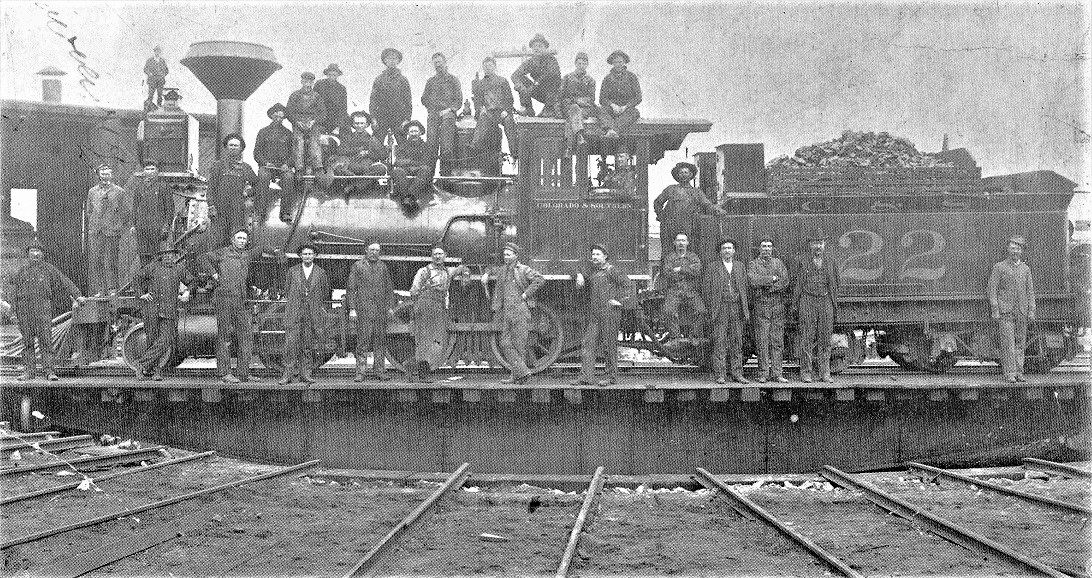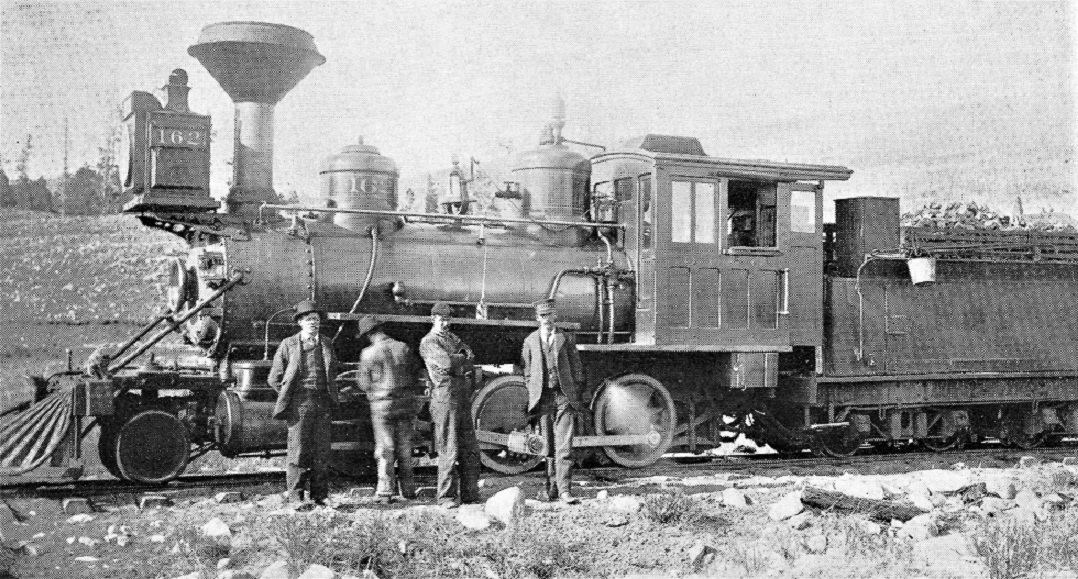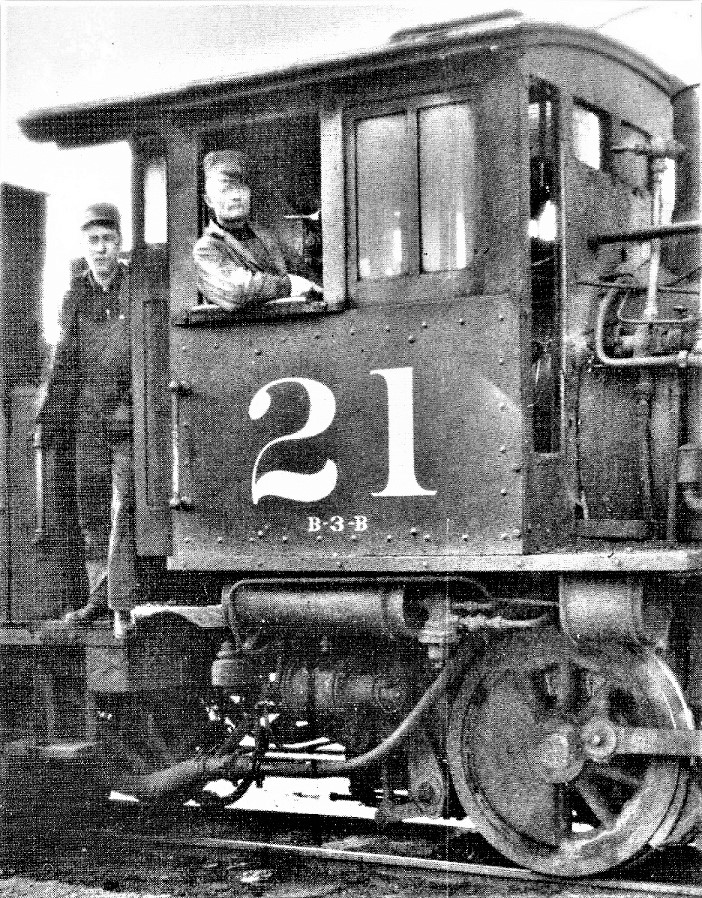Re: C&S #47, an Sn3 C-16 conversion
Posted by Jim Courtney on Dec 07, 2020; 4:47am
URL: http://c-sng-discussion-forum.254.s1.nabble.com/C-S-30-a-C-16-conversion-tp15055p16120.html
OK, John, I've been perseverating about these apparent inside cab dimensions on the folio sheets. Just doesn't make sense to me that they would be recorded that way. So, let's try out this thought:
The C&S locomotive folios supposedly were drawn up c.1899-1903, at the beginning of the new company. The fact that most of the locomotive diagrams have McConnell stacks is consistent. So what if the cab dimensions are truly outside dimensions, but only at that point in time. The folios might even have been inherited from the receiver or an even earlier UP record, and merely relabeled as C&S folios. In other words, were C&S cabs smaller in 1900 than say 1910 or 1918 or 1930?
Case in point is C&S 22 at about 1900, posed on the Como turntable:

In Kindig, et al., Pictorial Supplement . . .
I chose this right angle view because I'm not good at that perspective stuff. Per the folio sheet for C&S 22, the cab length was 5'-3", drivers are 37" in diameter. By my amateur measure and use of simple proportion, I come up with a 1900 cab length of about 5'-5", close to the folio. I get a calculated cab height (top of floor to peak of roof curvature) of 6'-7". The 22 folio has no cab height inked in, but the two dimensions are close to those of the Cooke 2-8-0 folio cab dimensions (5'-2.5" and 6'-7.5").
Prior to 1899, number 22 was numbered 162 on the DL&G. I tried cab calculations with a bit of perspective with this view, sometime after the 1894 boiler rebuild:

My uncertain math comes up with a cab length of 5' - 3.8", again very close to the folio. I had difficulty in the vertical measure of the cab height but I get 6' - 5" to 7".
I had always assumed that the original wooden cabs were merely steel sheathed beginning about 1902-1906, but it is quite possible that the cabs were new construction, becoming longer, taller and wider with subsequent shopping and rebuilding. That would explain the discrepancy between the folio dimensions and the observed dimensions in photos 10 to 20 years later. So, measuring existent locomotives wouldn't reconcile with the folio sheets
Does this explain why model manufactures made the cabs undersized, seeking accuracy from the only printed records, not recognizing the difference that occurred over time?
Please check my work, John--as McCoy would say, "I'm a doctor, not an engineer".
And while you're at it, please give me your best estimate of the cab length and height from this earlier view of C&S 21.

I believe this is the original wood cab with simple steel sheathing applied, sometime between the new lettering (1906) and the closing of the Highline (1911). Note the cab still has the clerestory on top, like C&S 22 above. To me, this cab looks smaller in length and height than the all steel cab in the 1918 Otto Perry photo of number 21 above.
Thanks,
Jim
URL: http://c-sng-discussion-forum.254.s1.nabble.com/C-S-30-a-C-16-conversion-tp15055p16120.html
OK, John, I've been perseverating about these apparent inside cab dimensions on the folio sheets. Just doesn't make sense to me that they would be recorded that way. So, let's try out this thought:
The C&S locomotive folios supposedly were drawn up c.1899-1903, at the beginning of the new company. The fact that most of the locomotive diagrams have McConnell stacks is consistent. So what if the cab dimensions are truly outside dimensions, but only at that point in time. The folios might even have been inherited from the receiver or an even earlier UP record, and merely relabeled as C&S folios. In other words, were C&S cabs smaller in 1900 than say 1910 or 1918 or 1930?
Case in point is C&S 22 at about 1900, posed on the Como turntable:

In Kindig, et al., Pictorial Supplement . . .
I chose this right angle view because I'm not good at that perspective stuff. Per the folio sheet for C&S 22, the cab length was 5'-3", drivers are 37" in diameter. By my amateur measure and use of simple proportion, I come up with a 1900 cab length of about 5'-5", close to the folio. I get a calculated cab height (top of floor to peak of roof curvature) of 6'-7". The 22 folio has no cab height inked in, but the two dimensions are close to those of the Cooke 2-8-0 folio cab dimensions (5'-2.5" and 6'-7.5").
Prior to 1899, number 22 was numbered 162 on the DL&G. I tried cab calculations with a bit of perspective with this view, sometime after the 1894 boiler rebuild:

My uncertain math comes up with a cab length of 5' - 3.8", again very close to the folio. I had difficulty in the vertical measure of the cab height but I get 6' - 5" to 7".
I had always assumed that the original wooden cabs were merely steel sheathed beginning about 1902-1906, but it is quite possible that the cabs were new construction, becoming longer, taller and wider with subsequent shopping and rebuilding. That would explain the discrepancy between the folio dimensions and the observed dimensions in photos 10 to 20 years later. So, measuring existent locomotives wouldn't reconcile with the folio sheets
Does this explain why model manufactures made the cabs undersized, seeking accuracy from the only printed records, not recognizing the difference that occurred over time?
Please check my work, John--as McCoy would say, "I'm a doctor, not an engineer".
And while you're at it, please give me your best estimate of the cab length and height from this earlier view of C&S 21.

I believe this is the original wood cab with simple steel sheathing applied, sometime between the new lettering (1906) and the closing of the Highline (1911). Note the cab still has the clerestory on top, like C&S 22 above. To me, this cab looks smaller in length and height than the all steel cab in the 1918 Otto Perry photo of number 21 above.
Thanks,
Jim
Jim Courtney
Poulsbo, WA
Poulsbo, WA
| Free forum by Nabble | Edit this page |